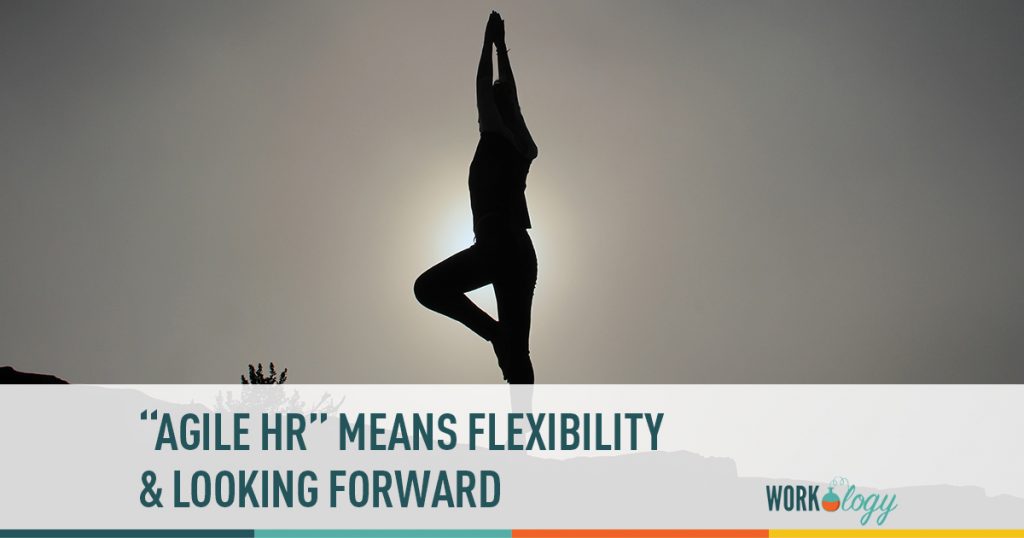“Agile: Able to move quickly and easily:
Ruth was as agile as a monkey.”
One of the major workplace trends mentioned in the Sodexo report on workplace trends is “The Agile Organization.” As I was reading this I thought to myself “What does that really mean?” What does it mean to be an agile organization, what does it mean to be agile in HR? Perhaps you have thought the same thing. (Nope, just you Mike, the rest of have a handle on this.) According to the brief description I saw in the introductory article, “The Agile Organization,” “organizations are seeking the holy grail of agility—speed plus stability—with an ultimate goal of responding to new conditions, all while keeping employees agile, too, by using disciplines such as mindfulness.” I don’t know about you but that did not really clear it up for me.
“Agile HR” Means Looking Ahead
To get a better definition of what an “agile organization” is, I turned to Josh Bersin, an HR guru, for his definition. In his newsletter, he describes how they asked “nearly 300 senior HR leaders about the intricacies of HR’s strategy and structure, its alignment to the business, and performance. Through a series of questions, they gave us information that allowed us to measure their HR agility and the HR and workplace practices that support it.”
From this survey they derived the following observations:
The prime factor in making HR departments agile is actually having line managers doing the day-to-day HR responsibilities. The report said that “agile HR organizations have equipped line managers to do a great job of managing their talent, allowing HR practitioners to spend more time designing and executing the HR strategic plan.”
The second factor that is necessary is the competence of senior management. “Within the domain of leadership performance, we found that leaders’ clear communication of the organization’s strategy is the most critical. This relationship makes sense; agility is predicated on change – you need to change to demonstrate agility. This change needs to be guided, so without clear communication, agility is moot.”
Other factors included:
· Balancing future and current needs while planning HR staffing
· Investing in improving the performance of the HR group
· Continuously evaluating to improve HR’s customer service
· Embedding few or no layers of authority within the HR group
· Using technology to house or share information, from emailing to sophisticated knowledge management software
· Optimizing HR resource use for maximal efficiency
· Predicting changes that are likely to occur affecting the HR group.
These are listed in order of importance. The study concludes with the statement: “The most agile HR organizations truly have their finger on the pulse of their effectiveness, efficiency, and customer service levels. They look to the future, predicting changes that will affect the way HR works and balancing the requirements posed by both short-term and long-term initiatives.”
It is this statement that made me pause.
Looking to the Future
In my conversations with HR people at conferences and meetings I rarely find people who are doing much looking to the future. Most are caught up in looking at yesterday or tomorrow, but not next year. I have never heard of an HR department that has a resident futurist. I haven’t heard of many who are tracking trends. Now, it may be that I have a limited sample. Perhaps the big companies are doing that kind of work. The quote at the top of this post is from the Oxford dictionary. To be agile like a monkey you have to be looking beyond the branch you are hanging on to. Your vision needs to be out in front several steps to chart your path through the branches of the future.
I am hoping that my sample is too small. If you work for a truly agile organization and you are looking several years ahead in HR I would love to hear from you. How do you do it?
My guess is, however, that most HR departments are not really that agile, despite the popularity of the concept.










2 Comments
An agile hr can bring many benefits to the company and your article helped gave a clear understanding of it,
Hi,
I think you misunderstood the concept of Agile HR. The core of Agile HR is to deliver value to customers (which in HRs case would be managers and employees within the company) continuosly, in a way that involves (internal) customers in regular conversations about what creates value for them. Essentially, agile HR is also about applying agile prinicples (which include, among others, continuous learning and improvement, transparency, trust, visualization, self-organization and sustainability). It’s about supporting the agility of the organization instead of creating obstacles by forming policies and rules, focusing on employee self-management and removing impediments for performing in a changing environment. Supporting managers and employees with the tools needed to succeed and giving prerequisites for performance and happiness. Read more in my book “Agile People – A Radical Approach for HR and Managers (That Leads to Motivated Employees) – it’s available on Amazon.
Good luck! / piamia
Comments are closed.